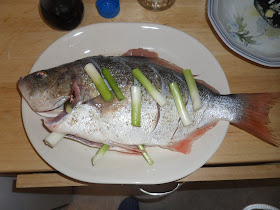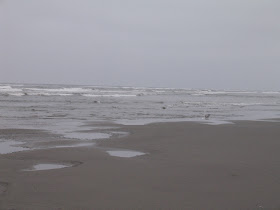Introduction of Surf Perch
Surf perch are viviparous that gives birth to live young; the spawning time is spring and early summer. Redtail surfperch grows to 4.5 lb, 16 inch length; and reach the age of 14 years. Average length at age 1 is 3.9 inch; at age 2 is 6.5 inch; by age 3 the average length of females is larger than males. Pile perch can grow to 3.5 lb, average is 1.5 to 2.5 lb. Striped perch can grow to 3lb, average around 1 lb.
Redtail surf perch are the largest and caught along the coasts. It is delicious and an eager biter, making surf perch fishing has lots of fun.
Where and When to Fish Surf Perch
 Usually, surf perch are darting in and out of the surging surf in search of food within 30 to 60 feet of the shoreline. Look for the places include steeply sloped beaches where the waves breaking hard; rocky areas in the sand; sandy areas near jetties; places where the shore cutting inward; or under docks next to pilings.
Usually, surf perch are darting in and out of the surging surf in search of food within 30 to 60 feet of the shoreline. Look for the places include steeply sloped beaches where the waves breaking hard; rocky areas in the sand; sandy areas near jetties; places where the shore cutting inward; or under docks next to pilings. Surf perch are available year-round. Spring and early summer are better because the surf perch school up along the shorelines for spawning. But a sunny week-end during the winter also is a chance to get the rod out. The best surf condition for surf perch fishing is when the surf is moderate to calm. You can google for the area surf forecast before you go fishing. The fish retreat from the rough water, and feed farther from shore when the surf is rough and the waves are breaking far from shore.
Most surf fishermen will tell you that the incoming tide is the best, as the fish will be moving up the beach to snatch up the food washing up by the tide. I catch surf perch in both incoming and outgoing tides. But I would like to fish surf perch in outgoing tide, because I hate to fight with the weeds being washed ashore by the incoming tide. Especially nears the high tides, the waves bring in tons of the weeds. I would like to fish before 9:00 AM, to take advantage of the early morning bite and to avoid the chilling effects of the afternoon winds. And don’t hesitate to move to another area of the beach or to another beach if the fishing is poor.
Surf perch Fishing Gear
 There are a lot of personal preferences when it comes to surf perch fishing tackle. I prefer using at least 9 foot long rod with 200 to 300 yards line holding capacity spinning reel, 15 lb test line, #4 or #2 hooks, and 3 or 4 oz pyramid sinker. Pyramid sinkers are easy to cast and tend to roll less in the surf. This tackle is good for light to heavy surf conditions on the beach. But using stronger line, such as 20 to 30 lb test line, will be better if fishing from the jetties or the rocky shore.
There are a lot of personal preferences when it comes to surf perch fishing tackle. I prefer using at least 9 foot long rod with 200 to 300 yards line holding capacity spinning reel, 15 lb test line, #4 or #2 hooks, and 3 or 4 oz pyramid sinker. Pyramid sinkers are easy to cast and tend to roll less in the surf. This tackle is good for light to heavy surf conditions on the beach. But using stronger line, such as 20 to 30 lb test line, will be better if fishing from the jetties or the rocky shore. A popular terminal tackle set-up for surf perch is: About one foot above the sinker attaches a 3-way swivel. On one loop tie on the first hook with 6-8 inches of monofilament; about one and half foot above the first hook attaches a second hook in the same way. My favorite terminal tackle set-up is: about 8 inch Or 20 cm above the sinker attaches a 3-way swivel, the other end of the loop tie to main fishing line, on the third loop tie on the hook with 2 foot long monofilament.
Use the light leader for the sinker and hook, so that if the sinker or hook gets stuck in the rocks you can break a light leader easier than the heavier line, thus freeing the line from the rocks.
Bait
 Sur fish will eat anything that they can find. Popular baits for surfperch fishing are mole crabs, marine worms, sand shrimp, mussels and clams. Some surf perch anglers are using plastic baits. Many anglers gather crabs, worms and shrimp during low tide from the same beaches they’re going to fish later. My favorite baits for surf perch on the beach first is razor clam when the razor clam digging season is available; second is sand worms; third is other kind clams. I did try plastic shrimp baits for surf perch fishing several times, but I didn’t catch any perch with the plastic baits. I use shrimps most when fishing on the docks, and work very well.
Sur fish will eat anything that they can find. Popular baits for surfperch fishing are mole crabs, marine worms, sand shrimp, mussels and clams. Some surf perch anglers are using plastic baits. Many anglers gather crabs, worms and shrimp during low tide from the same beaches they’re going to fish later. My favorite baits for surf perch on the beach first is razor clam when the razor clam digging season is available; second is sand worms; third is other kind clams. I did try plastic shrimp baits for surf perch fishing several times, but I didn’t catch any perch with the plastic baits. I use shrimps most when fishing on the docks, and work very well.Footwear
Your feet are going to get wet while fishing in the surf. If air and water temperatures are comfortable, you can simply wear shorts and sandals and get wet while fishing surf perch. Generally, hip boots and chest wader are very helpful in keeping your dry. In cold and rainy day, chest wader is necessary and keeps you warm and comfortable.
Surf Perch Fishing Tips
Don’t forget to buy the fishing license before you go fishing. And the daily limit for surf perch is 15-fish a day.
Be prepared & fish safe with a friend if possible. It is highly recommended to wear a personal flotation device while fishing with wader in the water. Don’t get too close to the water when fishing from a jetty or from rocks, as a sudden big breaker can cover you and pull you into the ocean.
Don’t drive on the clam beds while driving on the Beach.
Share the beach with other people.
Since you may be moving along the beach and fishing in the water, it would be better if you have one thing like a nylon or rubber net that can be attached to your belt to hold your catches.
The surf perch bites seem half the time you miss them and half the time you get them.
 If you see a seal swimming in the surf, it is fishing for the same prey as you are, and the fish may not bite the baits.
If you see a seal swimming in the surf, it is fishing for the same prey as you are, and the fish may not bite the baits.Surf perch travel in small schools which usually consist of the same size fish. If you are regularly getting small fish, you may want to change your casting location to find a school of larger fish.
Surf perch is a very good eating fish if large enough. It can be filleted, fried, fried, or many other methods. It like most white meat fish and eat them as fresh as possible.




your article is informative. thanks. do you live in oregon or washington? I'm thinking of doing some surf perch fishing along the oregon coast.
ReplyDeleteSo PK, is this where it all began?
DeleteThank you for that, good tips. I would also mention there are times to NOT use the long rod--like when corbina are right at your feet and you are "sight casting" a live sand crab, no weight to them with 6 pound flouro line. Also, I would mention this chart http://www.tides4fishing.com/us/california/los-angeles which will show you which days have the best MOVEMENT from low to high tides, and what a difference that makes. Also, remember on the full moon days, pick the afternoon if you can, because in the morning, the fish have been feeding all night and tend not to bite. So much fun, so much to learn.
ReplyDeleteGreat informative piece thank you!
ReplyDeleteSurf fishing belts used not only to attached additional components but also to prevent water from entering your waiters in case of a fall. Outdoors Monkeys released the ODM Surf Belt in the summer of 2017.
ReplyDelete